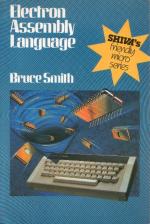
A&B Computing
 1st July 1984
1st July 1984
Categories: Review: Book
Author: Peter Mujtaba
Publisher: Shiva
Machine: Acorn Electron
Published in A&B Computing 1.08
There are two main types of book that are useful to the assembly language programmer. The first type is that which a beginner might read and it must be clear, well-written, informative and, probably most important, it must be fun to read. The second type is that which delves into the intricacies of assembly language, teaching helpful techniques and tricks for the more advanced programmer. My initial impression of Electron Assembly Language is that it is not sure which of these it is.
This book covers all the basics essential for learning assembly language...and a lot more! Bruce Smith has started with chapters that any beginner would be pleased to see at the start of this type of work. We see the "why" of assembly language, the manipulation of binary, BCD and logical operators all dealt with, but all too briefly. Why is it that authors assume that everyone understands these topics without need for extensive explanations and examples?
The chapters that follow deal very extensively with the registers, the addressing modes and the stack. These are quite excellent in their detail and will prove valuable as points of reference. Many of the mnemonics available in the BBC assembler are explained with some useful examples being given. But for me the highlight of the book is the chapter entitled "Prepacked Utilities". Within this chapter there are four useful listings, including a very useful register debugging utility which will be valuable for finding those elusive bugs so hard to trace when writing assembler code.
At the back of the book is the standard set of appendices covering information on ASCII codes, the 6502 assembler, a useful section of BASIC instructions in assembler, instruction cycle times and a multitude of other bits and pieces. There is also a section on the new BASIC 2 commands in the EQU family.
My overall impression of the book is that it is a learned work, covering many diverse aspects of BBC assembler. Unfortunately though, the book has covered so much that Bruce Smith has fallen into the trap of packing too much into too few pages. I feel that this is a good book as a refresher and concise reference to information on BBC assembler for someone who is not a beginner. I suggest that beginners keep away.


